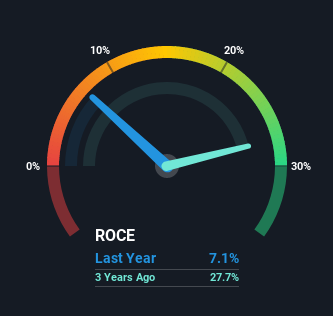- India
- /
- Auto Components
- /
- NSEI:STERTOOLS
Some Investors May Be Worried About Sterling Tools' (NSE:STERTOOLS) Returns On Capital
There are a few key trends to look for if we want to identify the next multi-bagger. Ideally, a business will show two trends; firstly a growing return on capital employed (ROCE) and secondly, an increasing amount of capital employed. This shows us that it's a compounding machine, able to continually reinvest its earnings back into the business and generate higher returns. However, after investigating Sterling Tools (NSE:STERTOOLS), we don't think it's current trends fit the mold of a multi-bagger.
Return On Capital Employed (ROCE): What is it?
For those that aren't sure what ROCE is, it measures the amount of pre-tax profits a company can generate from the capital employed in its business. Analysts use this formula to calculate it for Sterling Tools:
Return on Capital Employed = Earnings Before Interest and Tax (EBIT) ÷ (Total Assets - Current Liabilities)
0.071 = ₹272m ÷ (₹4.7b - ₹895m) (Based on the trailing twelve months to December 2020).
So, Sterling Tools has an ROCE of 7.1%. Ultimately, that's a low return and it under-performs the Auto Components industry average of 9.0%.
View our latest analysis for Sterling Tools

While the past is not representative of the future, it can be helpful to know how a company has performed historically, which is why we have this chart above. If you're interested in investigating Sterling Tools' past further, check out this free graph of past earnings, revenue and cash flow.
How Are Returns Trending?
In terms of Sterling Tools' historical ROCE movements, the trend isn't fantastic. To be more specific, ROCE has fallen from 28% over the last five years. Given the business is employing more capital while revenue has slipped, this is a bit concerning. This could mean that the business is losing its competitive advantage or market share, because while more money is being put into ventures, it's actually producing a lower return - "less bang for their buck" per se.
On a side note, Sterling Tools has done well to pay down its current liabilities to 19% of total assets. So we could link some of this to the decrease in ROCE. Effectively this means their suppliers or short-term creditors are funding less of the business, which reduces some elements of risk. Some would claim this reduces the business' efficiency at generating ROCE since it is now funding more of the operations with its own money.
What We Can Learn From Sterling Tools' ROCE
In summary, we're somewhat concerned by Sterling Tools' diminishing returns on increasing amounts of capital. Yet despite these poor fundamentals, the stock has gained a huge 138% over the last five years, so investors appear very optimistic. In any case, the current underlying trends don't bode well for long term performance so unless they reverse, we'd start looking elsewhere.
If you'd like to know more about Sterling Tools, we've spotted 2 warning signs, and 1 of them shouldn't be ignored.
While Sterling Tools isn't earning the highest return, check out this free list of companies that are earning high returns on equity with solid balance sheets.
When trading Sterling Tools or any other investment, use the platform considered by many to be the Professional's Gateway to the Worlds Market, Interactive Brokers. You get the lowest-cost* trading on stocks, options, futures, forex, bonds and funds worldwide from a single integrated account. Promoted
New: Manage All Your Stock Portfolios in One Place
We've created the ultimate portfolio companion for stock investors, and it's free.
• Connect an unlimited number of Portfolios and see your total in one currency
• Be alerted to new Warning Signs or Risks via email or mobile
• Track the Fair Value of your stocks
This article by Simply Wall St is general in nature. It does not constitute a recommendation to buy or sell any stock, and does not take account of your objectives, or your financial situation. We aim to bring you long-term focused analysis driven by fundamental data. Note that our analysis may not factor in the latest price-sensitive company announcements or qualitative material. Simply Wall St has no position in any stocks mentioned.
*Interactive Brokers Rated Lowest Cost Broker by StockBrokers.com Annual Online Review 2020
Have feedback on this article? Concerned about the content? Get in touch with us directly. Alternatively, email editorial-team (at) simplywallst.com.
About NSEI:STERTOOLS
Sterling Tools
Manufactures and sells high tensile cold forged fasteners to original equipment manufacturers in India.
Excellent balance sheet average dividend payer.
Similar Companies
Market Insights
Community Narratives



